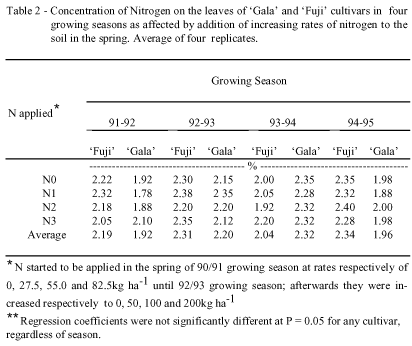Since there is no chemical method to assess N availability from field soil samples, this nutrient is still recommended based on regional field trials. This study aimed to evaluate the effect of spring application of N to the soil on fruit yield of apple cultivars. Two experiments were carried out, respectively for ‘Gala’ and ‘Fuji’. The trees, grafted on MM 106 rootstock, were planted in 1987, spaced 4.50 x 1.80m, in a clayed Oxisol (Hapludox) with 4.0% of organic matter, in Vacaria (RS), Southern Brazil. Treatments were applied annually, from the spring of 1990, in the tree row, over a 1.5-m-wide strip, as urea, and consisted of four rates of N corresponding to 0, 27.5, 55.0 and 82.5kg ha-1 in the first three years, and respectively 0, 50, 100 and 120kg ha-1 in the remaining two years. Data were collected for four years, starting at the 91/92 growing season. Application of increasing rates of N to the soil during five years had no effect on fruit yield and on concentration of N in the leaves regardless of year and cultivar. Average annual fruit yield varied from 50 to 70t ha-1 for ‘Gala’ and from 39 to 89t ha-1 for ‘Fuji’, but in the entire period the average yield was similar for both cultivars, approximately 56t ha-1. Concentration of N in the leaves was always in the normal range (2.0 to 2.5%) for ‘Fuji’, and slightly lower for ‘Gala’, but above 1.9%. Total N requirement for tree growth and fruiting, thus, came from soil organic matter decay.
apple yield; nitrogen; ‘Gala’; ‘Fuji’


